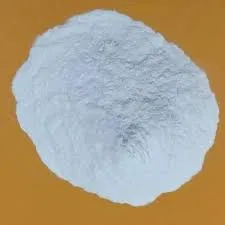
Nov . 25, 2024 12:50 Back to list
hydroxypropyl methyl cellulose cas no
Understanding Hydroxypropyl Methylcellulose Properties, Applications, and Benefits
Hydroxypropyl methylcellulose (HPMC), identified by its CAS number 9004-65-3, is a non-ionic cellulose ether derived from natural cellulose. This versatile polymer features unique properties that make it a popular ingredient across various industries, including food, pharmaceuticals, cosmetics, and construction.
Chemical Structure and Properties
HPMC is synthesized through the alkali treatment of cellulose followed by etherification with propylene oxide and methyl chloride. The resulting compound retains the cellulose backbone but incorporates hydroxypropyl and methyl groups, enhancing its solubility and versatility. One of HPMC's most notable characteristics is its ability to dissolve in cold water, unlike many other cellulose derivatives. This property allows it to form clear, viscous solutions, making it an ideal thickening agent.
In addition to its solubility, HPMC boasts excellent film-forming properties, flexibility, and stability across a wide range of pH levels and temperatures. These attributes make it an attractive choice for many applications, as it can maintain its functionality under different conditions.
Applications
1. Food Industry In the food industry, HPMC serves multiple roles, including acting as a thickener, emulsifier, and stabilizer. It is commonly found in gluten-free baked goods, providing improved texture and moisture retention. HPMC is also utilized in sauces, dressings, and ice creams, where it enhances mouthfeel and prevents ice crystal formation. Importantly, HPMC is classified as a food additive and is considered safe for consumption, which adds to its appeal in food formulations.
hydroxypropyl methyl cellulose cas no

2. Pharmaceuticals HPMC is widely used in the pharmaceutical sector, particularly in the formulation of tablets and capsules. It functions as a binder and coating agent, ensuring the uniform distribution of active pharmaceutical ingredients (APIs). Furthermore, HPMC is often employed in controlled-release formulations due to its ability to modulate the release rate of drugs. This enables consistent therapeutic effects and enhances patient compliance.
3. Personal Care Products In cosmetics and personal care formulations, HPMC acts as a thickening and stabilizing agent. It is commonly found in products such as lotions, creams, and shampoos, contributing to smooth textures and improving product stability. Additionally, HPMC enhances the spreadability of products, making them easier to apply.
4. Construction In the construction industry, HPMC is incorporated into cement-based products like tiles and adhesives. Here, it improves workability, water retention, and adhesion, ensuring that construction materials remain workable for longer periods. Its use contributes to the final strength and durability of construction applications.
Benefits of HPMC
The benefits of using hydroxypropyl methylcellulose are manifold. Its non-toxic, biodegradable nature makes it an environmentally friendly choice for many applications. Moreover, HPMC is hypoallergenic and suitable for individuals with sensitivities, particularly in personal care and food products. The versatility of HPMC, along with its efficacy in enhancing product performance, positions it as a critical ingredient across diverse sectors.
Conclusion
In summary, hydroxypropyl methylcellulose is an invaluable polymer with wide-ranging applications due to its unique properties and functionality. From food and pharmaceuticals to personal care and construction, HPMC serves as a multifunctional ingredient that enhances product quality and consumer experience. As industries continue to evolve, the demand for innovative materials like HPMC is likely to increase, underscoring its importance in modern formulations. Whether used as a thickener, binder, or stabilizer, hydroxypropyl methylcellulose remains a cornerstone in the development of effective and consumer-friendly products.
-
Versatile Hpmc Uses in Different Industries
NewsJun.19,2025
-
Redispersible Powder's Role in Enhancing Durability of Construction Products
NewsJun.19,2025
-
Hydroxyethyl Cellulose Applications Driving Green Industrial Processes
NewsJun.19,2025
-
Exploring Different Redispersible Polymer Powder
NewsJun.19,2025
-
Choosing the Right Mortar Bonding Agent
NewsJun.19,2025
-
Applications and Significance of China Hpmc in Modern Industries
NewsJun.19,2025







